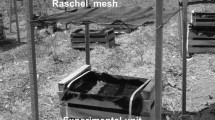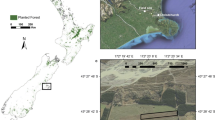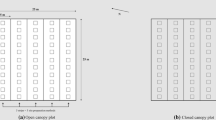Abstract
Silvicultural approaches at forest plantations with wider initial tree spacing have created potential for increased understory vegetation growth in response to increased light and greater nutrient resources. In consequence understory vegetation can fill a more important role in forest ecosystems, especially in interactions (competition or facilitation) between understorey vegetation and forests trees that might affect tree growth and nutrition. Considerable research has been carried out on plant interference. However, the experimental designs used in these studies vary from one study to another, and from species to species depending on the aims, objectives and practicalities of the studies. Thus there is no optimum design for competition experiments. This review discusses designs available in studying plant interferences in a glasshouse, particularly the effects of below-ground interaction of understorey vegetation and forest trees.
Similar content being viewed by others
References
Austin MP, Groves RH, Fresco LMF, Kaye PE (1985) Relative growth of six thistle species along a nutrient gradient with multispecies competition. J Ecol 73:667–684
Barbour MG, Burk JH, Pitts WD (1987) Terrestrial plant ecology, 2nd edn. Benjamin/Cummings Publishing, Menlo Park, p 294
Belcher JW, Keddy PA, Twolan-Strutt L (1995) Root and shoot competition intensity along a soil depth gradient. J Ecol 83:673–682
Binkley D, Giardina C, Bashkin MA (2000) Soil phosphorus pools and supply under the influence of Eucalyptus saligna and nitrogen-fixing Albizia falcataria. For Ecol Manage 128:241–247
Bormann BT, DeBell DS (1981) Nitrogen content and other soil properties related to age of red alder stands. Soil Sci Soc Am J 45:428–432
Brockerhoff EG, Jactel H, Parrotta JA, Quine CP, Sayer J (2008) Plantation forests and biodiversity: oxymoron or opportunity? Biodivers Conserv 17:925–951
Burkes CE, Will RE, Barron-Gafford GA, Teskey RO, Shiver B (2003) Biomass partitioning and growth efficiency of intensively managed Pinus taeda and Pinus elliotii stands of different planting densities. For Sci 49:224–234
Callaway RM (1995) Positive interactions among plants. Bot Rev 61:306–349
Clinton PW, Frampton CM, Mead DJ (1994) Modelling competitive pasture effects on nutrient uptake by Pinus radiata. NZ J For Sci 24:268–278
Condron LM, Davis MR, Newman RH, Cornforth S (1996) Influence of conifers on the forms of phosphorus in selected New Zealand grassland soils. Biol Fertil Soils 21:37–42
Craine JM, Dybzinski R (2013) Mechanisms of plant competition for nutrients, water and light. Funct Ecol 27:833–840
Davis MR, Lang MH (1991) Increased nutrient availability in topsoils under conifers in the South Island high country. NZ J For Sci 21:165–179
DeAngelis DL, Post WM, Travis CC (1986) Positive feedback in natural systems. Springer-Verlag, Berlin, p 290
Donald CM (1958) The interaction of competition for light and for nutrients. Aust J Agric Res 9(4):421–435
Firbank LG, Watkinson AR (1990) On the effects of competition: from monocultures to mixtures. In: Grace JB, Tilman D (eds) Perspectives on plant competition. Academic Press, London, pp 165–192
Folkard PJ, Fraser LH, Carlyle CN, Tucker RE (2012) Forage production potential in a ponderosa pine stand: effects of tree spacing on rough fescue and understorey plants after 45 years. J Ecosyst Manage 13(3):1–14
Forrester DI, Bauhus J, Cowie AL, Vanclay JK (2006a) Mixed-species plantations of Eucalyptus with nitrogen fixing trees. For Ecol Manage 233:211–230
Forrester DI, Cowie AL, Bauhus J, Wood J, Forrester RI (2006b) Effects of changing the supply of nitrogen and phosphorus on growth and interactions between Eucalyptus globulus 25 and Acacia mearnsii in a pot trial. Plant Soil 280:267–277
Freckleton RP, Watkinson AR (1999) The mis-measurement of plant competition. Funct Ecol 13:285–287
Freckleton RP, Watkinson AR (2000) Design for greenhouse studies of interactions between plants: an analytical perspective. J Ecol 88:386–391
Gadgil RL, Charlton JFL, Sandberg AM, Allen PJ (1988) Establishment of selected legumes in a mid-rotation Pinus radiata plantation. NZ J For Sci 18:210–220
Gillespie AR, Pope PE (1989) Alfalfa N2-fixation enhances the phosphorus uptake of walnut in interplantings. Plant Soil 113:291–293
Grace JB (1988) The effects of plant age on the ability to predict mixture performance from monoculture growth. J Ecol 76:152–156
Hall RL (1974) Analysis of the nature of interference between plants of different species. I. Concept and extension of the de Wit analysis to examine effects. Aust J Agric Res 25:739–747
Hart SA, Chen HYH (2008) Fire, logging, and overstory affect understory abundance, diversity, and composition in boreal forest. Ecol Monogr 78:123–140
Hunter AF, Aarssen LW (1988) Plants helping plants. New evidence indicates that beneficence is important in vegetation. Bioscience 38:34–40
Joffre R, Rambal S (1988) Soil water improvement by trees in the rangelands of southern Spain. Oecologia Plantarum 9:405–422
Jose S, Ranasinghe S, Ramsey CL (2010) Longleaf pine (Pinus palustris P. Mill.) restoration using herbicides: overstory and understory vegetation responses on a coastal plain flatwoods site in Florida, U.S.A. Restor Ecol 18(2):244–251
Kikvidze Z, Armas C, Pugnaire FI (2005) The effect of initial biomass in manipulative experiments on plants. Funct Ecol 20:1–3
Law R, Watkinson AR (1987) Response-surface analysis of two-species competition: an experiment on Phleum arenarium and Vulpia fasciculata. J Ecol 75:871–886
Mason EG, Milne PG (1999) Effects of weed control, fertilization, and soil cultivation on the growth of Pinus radiata at midrotation in Canterbury, New Zealand. Can J For Res 29:985–992
Mead DJ (2005) Opportunities for increasing plantation productivity. How much? How quickly? How realistic? Biomass Bioenergy 28:249–266
Mead DJ (2010) Results of 16 years of study in a temperate silvopastoral experiment with Pinus radiata in New Zealand. In: Kellimore LR (ed) Handbook on agroforestry: management practices and environmental impact. Nova Science Publishers, New York, pp 225–249
Miller TE (1994) Direct and indirect species interactions in an early old-field plant community. Am Nat 143:1007–1025
Montagnini F (2000) Accumulation in above-ground biomass and soil storage of mineral nutrients in pure and mixed plantations in a humid tropical lowland. For Ecol Manage 134:257–270
Nambiar EKS, Zed PG (1980) Influence of weeds on the water potential, nutrient content and growth of young radiata pine. Aust For Res 10:279–288
Newman EI, Rovira AD (1975) Allelopathy among some British grassland species. J Ecol 63:727–737
Nye PH, Tinker PB (1977) Solute movement in the soil-root system. Blackwell Scientific Publications, Oxford, p 342
Pannel CA (1993) The influence of phosphorus supply on below-ground interferences between browntop and white clover. PhD Thesis. Massey University, New Zealand, p 219
Payn TW, Skinner MF, Hill RB, Thorn AJ, Scott J, Downs S, Chapman H (2000) Scaling up or scaling down: the use of foliage and soil information for optimising the phosphate nutrition of radiata pine. For Ecol Manage 138:79–89
Radosevich S, Holt J, Ghersa C (1997) Association of weeds and crops. Weed ecology: implication for management, 2nd edn. Wiley, New York, p 589
Radosevich SR, Holt JS, Ghersa CM (2007) Ecology of weeds and invasive plants: relationship to agriculture and natural resource management, 3rd edn. Wiley, New York, p 472
Richards JH, Caldwell MM (1987) Hydraulic lift: substantial nocturnal water transport between soil layers by Artemisia tridentata roots. Oecologia 73:486–489
Richardson B, Vanner A, Davenhill N, Balneaves J, Miller K, Ray J (1993) Interspecific competition between Pinus radiata and some common weed species—first-year results. NZ J For Sci 23(2):179–193
Richardson B, Vanner A, Ray J, Davenhill N, Coker G (1996) Mechanisms of Pinus radiata growth suppression by some common forest weed species. NZ J For Sci 26(3):421–437
Richardson B, Whitehead D, McCracken IJ (2002) Root-zone water storage and growth of Pinus radiata in the presence of a broom understorey. NZ J For Sci 32(2):208–220
Richardson B, Watt MS, Mason EG, Kriticos DJ (2006) Advances in modelling and decision support systems for vegetation management in young forest plantations. Forestry 79:29–42
Rivaie AA (2011) Growth response of broom (Cytisus scoparius) growing with and without radiata pine (Pinus radiata) seedlings to different P levels in soil. J For Res 22(4):597–602
Rivaie AA (2014) The effects of understory vegetation on P availability in Pinus radiata forest stands: a review. J For Res 25(3):489–500
Rivaie AA, Tillman RW (2010) Phosphorus fertiliser induced changes in the soil plant-available P, the P nutrition and the growth of Pinus radiata seedlings grown in association with understory. J For Res 21(2):129–139
Rubilar R, Blevins L, Toro J, Vita A, Muñoz F (2008) Early response of Pinus radiata plantations to weed control and fertilization on metamorphic soils of the Coastal Range, Maule Region, Chile. Bosque 29:74–78
Scott JT, Condron LM (2004) Short term effects of radiata pine and selected pasture species on soil organic phosphorus mineralisation. Plant Soil 266:153–163
Silvertown JW, Doust JL (1993) Introduction to plant population biology, 3rd edn. Blackwell Scientific Publication, Oxford, p 210
Snaydon RW (1991) Replacement or additive designs for competition studies. J Appl Ecol 28:930–946
Strong DR, Simberloff D, Abele LG, Thistle AB (1984) Ecological communities: conceptual issues and the evidence. Princeton University Press, Princeton, p 613
Tilman D (1990) Mechanisms of plant competition for nutrients: The elements of predictive theory of competition. In: Grace JB, Tilman D (eds) Perspective of plant competition. Academic Press, London, pp 117–141
Twolan-Strutt L, Keddy PA (1996) Above- and below-ground competition intensity in two contrasting wetland plant communities. Ecology 77:259–270
Vandermeer JH (1989) The ecology of intercropping. Cambrige University Press, Cambridge, p 237
Warren JF, Lill WJ (1975) The influence of aerial shields on plant growth environments in competition experiments. Ann Bot 39:1141–1142
Watt MS, Whitehead D, Mason EG, Richardson B, Kimberley MO (2003a) The influence of weed competition for light and water on growth and dry matter partitioning of young Pinus radiata, at a dryland site. For Ecol Manage 183:363–376
Watt MS, Whitehead D, Richardson B, Mason EG, Leckie AC (2003b) Modelling the influence of weed competition on the growth of for light and water on growth of young Pinus radiata at a dryland site. For Ecol Manage 178:271–286
Zhang F, Li L (2003) Using competitive and facilitative interactions in intercropping systems enhances crop productivity and nutrient-use efficiency. Plant Soil 248:305–312
Zou X, Binkley D, Caldwell BA (1995) Effects of dinitrogen-fixing trees on phosphorus biogeochemical cycling in contrasting forests. Soil Sci Am J 59:1452–1458
Zou CB, Breshears DD, Newman BD, Wilcox BP, Gard MO, Rich PM (2008) Soil water dynamics under low- versus high- ponderosa pine tree density: ecohydrological functioning and restoration implications. Ecohydrology 1:309–315
Acknowledgments
The author thanks Prof Russ Tillman (Massey University), Dr Tim Payn (Centre for Sustainable Forest Management of New Zealand, Forest Research Ltd., Rotorua) and Hong Zhu, Ph.D. for their suggestions on the manuscript.
Funding
This study was financially supported by Massey University and the Centre for Sustainable Forest Management at Forest Research Institute, New Zealand.
Author information
Authors and Affiliations
Corresponding author
Additional information
The online version is available at http://www.springerlink.com
Corresponding editor: Zhu Hong
Rights and permissions
About this article
Cite this article
Rivaie, A.A. Plant interference and trial designs to study it in a glasshouse: a review. J. For. Res. 27, 231–237 (2016). https://doi.org/10.1007/s11676-015-0190-1
Received:
Accepted:
Published:
Issue Date:
DOI: https://doi.org/10.1007/s11676-015-0190-1




